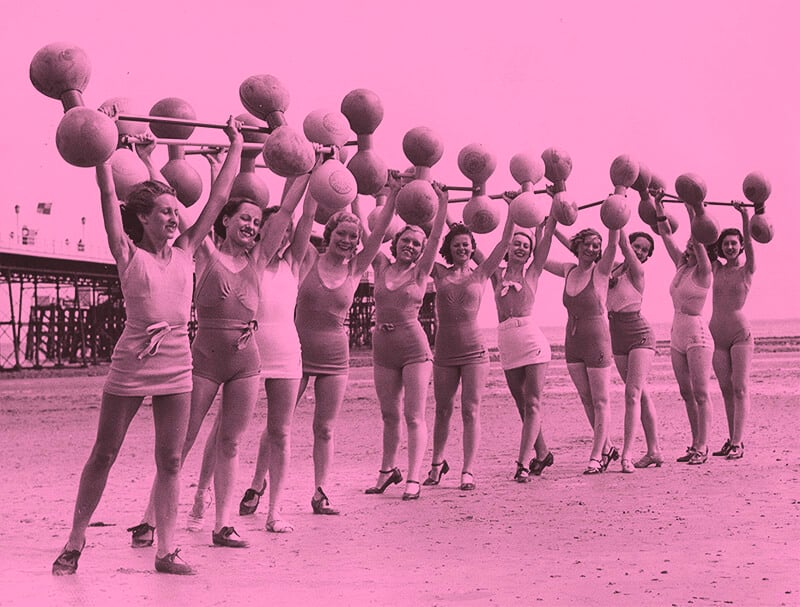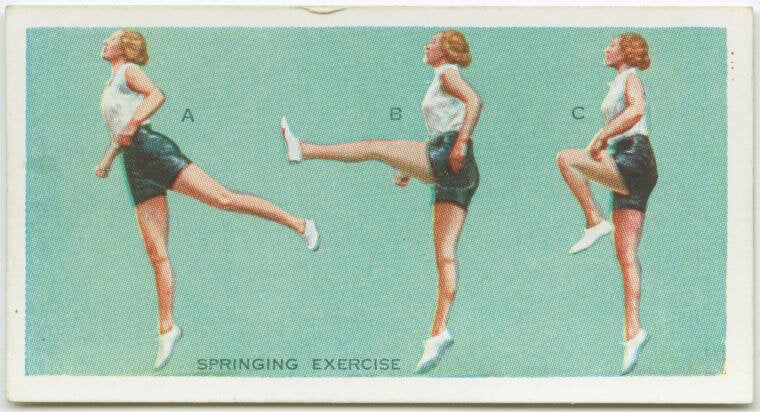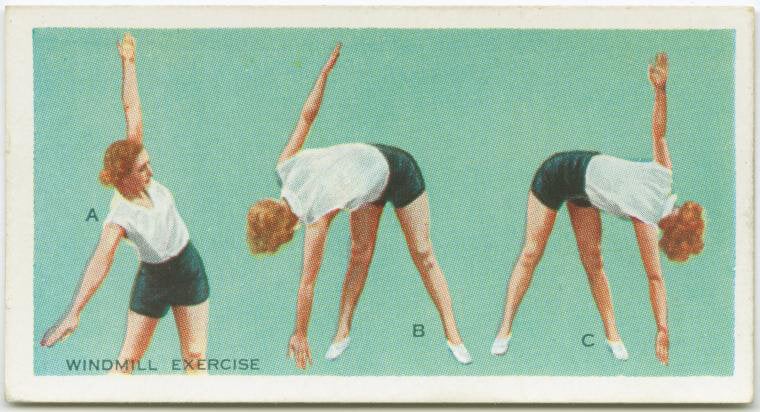Nevertheless, She Lifted

Let’s Get Physical: How Women Discovered Exercise and Reshaped the World by Danielle Friedman. G.P. Putnam’s Sons, 352 pages.
In the late 1950s, Bonnie Prudden, a fitness instructor and researcher who played a key role in the establishment of the President’s Council on Youth Fitness, led an exercise program at a Westchester women’s prison. The program was advertised with posters in the prison cafeteria reading “Be Slim and Sophisticated” and “Your Secret Weapon: A Lovely, Lissome Figure.” The prison superintendent thought of exercise as a way to keep unruly women in line—she hoped the program would help prevent riots.
Danielle Friedman’s new book Let’s Get Physical traces the recent history of women’s fitness in the United States, primarily through a series of biographical sketches of women who, like Prudden, have shaped that history. Each chapter centers on a woman, or several, who pioneered a major fitness trend in a given decade. The first chapter focuses on Prudden, detailing her research on children’s fitness, her many popular books promoting exercise for women, her prison program and its accompanying New York Times coverage, and her TV show. Later chapters focus on Lotte Berk, the originator of the barre workouts that emerged in the 1960s, and, of course, Jane Fonda’s ’80s aerobics.
For decades women were discouraged from exercising because it was believed that too much exercise could make their uteruses fall out.
Friedman’s lively anecdotes about these women and their early followers are fun to read. The book presents a dynamic cast of characters, many of whom are little-known now, like Lisa Lyon, a bodybuilder who posed for Playboy and was profiled by Eve Babitz in Esquire (Babitz wrote that she had a “perfect little Bardot-Ronstadt face”); or Janice Darling, an instructor at Jane Fonda’s original workout studio who was one of the few Black fitness instructors of the era and who credited her fitness routine with helping her recover from an accident that broke both her legs and severed a muscle in one eye. It’s fun, too, to gawk at the now obviously ridiculous sexism many of them faced. Friedman writes, for instance, that for decades women were discouraged from exercising because it was believed that too much exercise could make their uteruses fall out.
Friedman clearly views the telling of this history as a feminist project. As she writes, “American women’s fitness history is more than a series of misguided ‘crazes.’ It’s the story of how women have chosen to spend a collective billions of dollars and hours in pursuit of health and happiness. In many ways, it’s the story of what it has meant to be a woman over the past seven decades.” She is right that exercise is a significant concern for many women, and so there is a feminist stake in refusing to dismiss or overlook its history. But the fact that there is a compelling feminist argument for studying the history of women’s fitness does not make that history, in and of itself, feminist—something Friedman’s book struggles to grasp.

While Prudden’s prison program seems like a clear indication that fitness has long been a tool to discipline and control women, Friedman takes a different view. She writes that “when women first began exercising en masse, they were participating in something subversive: the cultivation of physical strength and autonomy,” which, in her view, leads nearly inexorably to inner strength and autonomy. Let’s Get Physical presents an overwhelmingly positive picture of the role of fitness in women’s lives—the book’s main villains are barriers to women’s participation in exercise, in the form of racism, sexism, and, occasionally, capitalism. Friedman notes, for instance, that “many poor Americans were denied the leisure time, means, and space to exercise.” It was for this reason, she writes, that “fitness developed a reputation as a white person’s pursuit,” and that for decades, fitness clubs refused admittance to Black prospective members.
Friedman does mention the unattainable standards of physical perfection pushed on women by America’s fitness culture, but more often than not she offers exercise itself as an antidote. The idea that women start working out because they want to change their bodies but keep exercising because they love how it makes them feel—their hang-ups falling away as they dance and run and pelvic tilt—recurs over and over again throughout the book. In the introduction, Friedman recounts her own experience taking Pure Barre classes. She was drawn there, initially, by the promise of a body like a prototypical ballerina’s, but, after several classes, she found something else:
The workout made me strong in parts of my body I hadn’t realized were weak. It allowed me, for the first time in my life, to carry grocery bags without stopping to rest after three minutes. I didn’t look like a ballerina, but I felt like one—light on my feet, energized, connected with my body in a totally new way.
A few pages later, this personal anecdote transforms into an organizing principle. She argues that “Like my experience with Pure Barre, many women start exercising to change their appearance, but they stick with it after discovering more meaningful rewards. For some, becoming strong helps them overcome the desire to shape their body for anyone else’s pleasure.” While she acknowledges that women’s fitness is “far from universally empowering,” her focus on the women who see their body image issues disappear before the fitness-studio mirror leads her to neglect the experiences of those who exercise despite it failing to fix their insecurities, or indeed, those who keep exercising (at least in part) because of them. This may be a consequence of both Friedman’s personal experience and her focus on the pioneers of new fitness movements. The women she interviews who were not pioneers themselves are all acolytes of one or another of Friedman’s fitness trailblazers. She’s speaking only to evangelists and the converted. Women with more complicated feelings—women who exercise even though they’ve never found salvation in it, or for whom it has been an unhealthy obsession—are not the focus here.
The book glosses over or rushes past the darker side of women’s fitness often enough that the rosy picture it paints feels woefully incomplete.
Friedman’s closing chapter uses Jessamyn Stanley, a Black, queer, fat yoga practitioner who works to make yoga more accessible, as proof that the present day is a turning point in fitness history, toward something more inclusive and joyful. But she neglects to seriously grapple with the ways in which Instagram—Stanley’s primary platform and, in Friedman’s telling, a central force in creating a more democratic fitness culture—has exacerbated women’s and girls’ body image issues. While it only became public knowledge that Facebook’s own internal research demonstrated that Instagram contributes to eating disorders in teenagers, and that the app actively promoted eating disorder content to teenage girls, it’s been clear to many that Instagram promotes an unhealthy physical ideal for years. Friedman briefly notes that “Instagram also perpetuates unrealistic and often toxic beauty standards, and the platform abounds with self-proclaimed fitness experts whose only qualification is their lack of visible body fat” but ultimately concludes that it’s been a crucial tool for expanding the range of what kinds of body types are accepted within fitness culture. She writes that in that regard, Instagram’s power “cannot be overstated.”
In positioning Stanley as the one to watch in the fitness space, Friedman also neglects to mention that Stanley’s Instagram following trails behind the likes of Kayla “Bikini Body Guide” Itsines and dozens of other conventionally attractive, predominantly white fitness influencers who use vaguely feminist captions to sell PDF guides to getting a bigger ass and a smaller waist. She mentions that “Stanley’s activism is part of a growing movement of radical body love. . . . she has been joined by scores of other fitness professionals—some of whom look like fit pros have looked for decades, some of whom don’t—who are working to undo decades of cultural programming about how a woman’s body ‘should’ look.” But she ignores the way in which many of the fitness influencers who do “look like fit pros have looked for decades” use the language of self-love to promote the same punishing physical standards Stanley hopes to challenge, pairing “empowering” slogans with weight-loss transformation photos. Friedman’s impulse to focus on the positive is understandable—as Elle Woods reminds us in one of the book’s two epigraphs, “Exercise gives you endorphins. Endorphins make you happy.”—but in its service, the book glosses over or rushes past the darker side of women’s fitness often enough that the rosy picture it paints feels woefully incomplete.
To Friedman’s credit, Let’s Get Physical does contain an undercurrent that pushes against the book’s main thesis that exercise helps women disregard the pressure to conform to a narrow physical ideal—a counter-narrative about how each time women have flocked to a new form of movement, the nature of the practice has eventually shifted to reinforce rigid bodily ideals and undercut whatever other benefits or freedoms it may have offered. Jazz dance becomes about weight loss rather than fun; weightlifting becomes about shapeliness rather than power; yoga becomes about litheness rather than calm. This adds some much-needed complexity, suggesting a halting if consistent forward progress. But even this counter-narrative is often over-simplified, ignoring the ways in which the pursuit of thinness was always at the heart of so many of the fitness trends chronicled, at least in their American iterations. For instance, Friedman details how Indra Devi, who she credits with bringing yoga to America, sold the practice as a way to become beautiful, and that this sales pitch is what enabled yoga to take off in the United States. Pages later, she argues that yoga became more focused on outward appearance only as its popularity grew, and that this shift in focus “reinforce[d] some of the very same pressures women were trying to escape” in their yoga practice.

The book has the energy of a cardio dance class; it’s most comfortable in motion, and her story is patterned on a kind of two-steps-forward, one-step-back choreography. She has trouble staying in a place where positive and negative influences sit alongside one another in tension. This is unfortunate, because there is a deeper, richer meaning to be mined in those tense places—for instance, in writing about those early fitness television shows, Friedman notes that even as they encouraged women to lose weight and develop curves, they fostered an intimacy that enabled women to talk about other concerns, like aging parents, alcoholism, and depression.
Early in Let’s Get Physical, Friedman writes about how Bonnie Prudden found that women couldn’t fathom taking time to exercise for themselves; she could only convince them to do it by marketing it as a wifely duty to keep one’s “honeymoon figure.” Friedman frames this as a clever way of getting women to prioritize their own needs, writing that getting women to exercise meant something “profound: taking time out of their day to care for themselves, when nearly every social institution stressed that a woman’s sole purpose in life was to care for others.” While she acknowledges that this approach had “mixed consequences,” she doesn’t consider the failure of the frame—are women really “taking time out of their day to care for themselves” at all if they’re doing it to keep a man?
Today, it often feels like the formula has flipped: many women can still only conceive of exercise as a way to mold their bodies to fit a demanding ideal that hasn’t really gone away, but it now has to be marketed as empowering—as a feminist reclamation of strength, as “self-care,” as “for you”—for us to justify it. Friedman tends to dismiss the ugliness concealed in this new formula, painting the history of women’s fitness as one of more or less straightforward feminist progress. Tellingly, the pandemic is mentioned as something that brought many women “a newfound appreciation for what their bodies could do, beyond how their bodies looked,” and a time when “the opportunity to be physically active provided many women with an indispensable form of self-care.” There is no mention of the many others who embarked on quests for “quarantine abs” or fretted over the “quarantine fifteen,” despite those concerns’ ubiquity on the early-pandemic internet.
Reviews of Friedman’s book have emphasized how fun it is, calling it “bouncy,” “energetic,” “zippy.” And indeed, the book goes down like Diet Coke, another product whose sales are driven by body panic. It tastes better than the real thing.